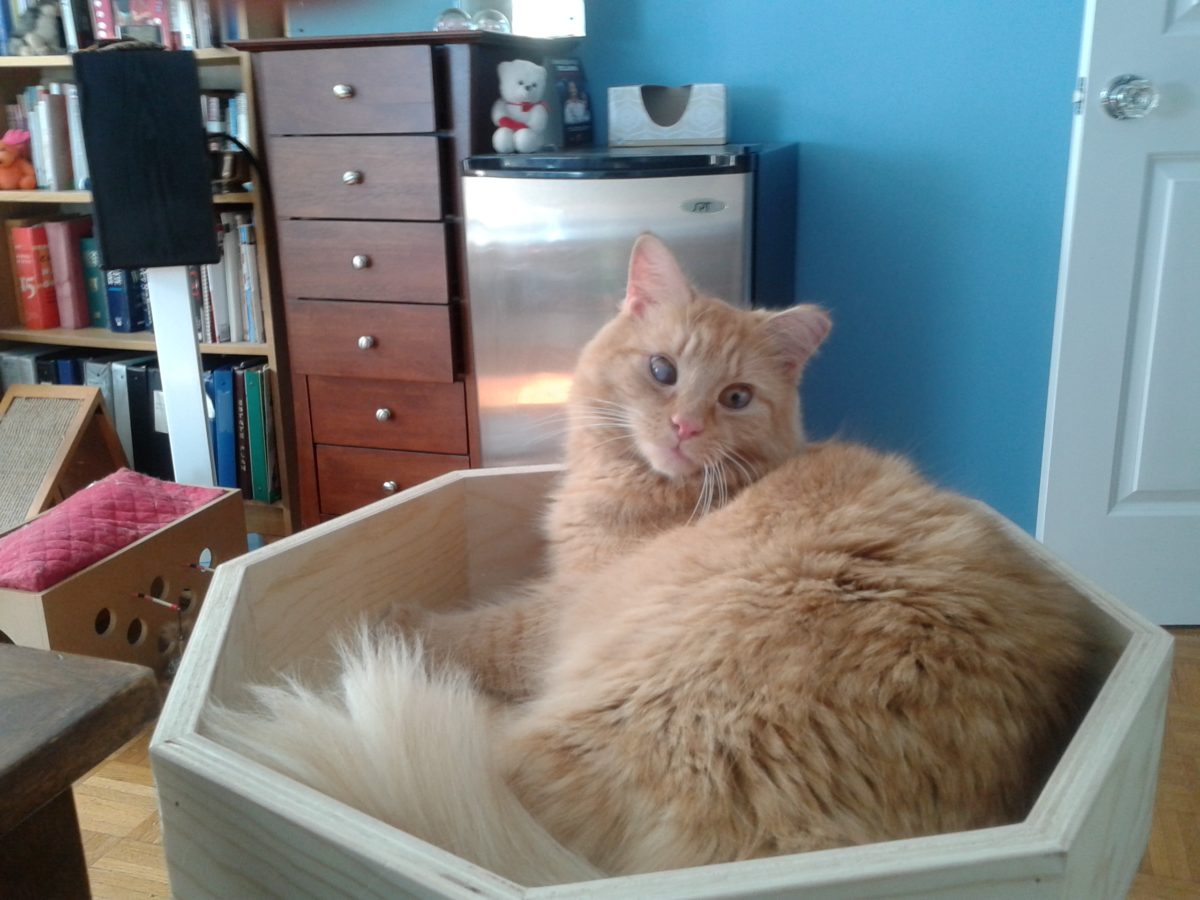How many times have you heard a cat person say, “Kitty likes to be touched, but only on her own terms.” They say it somewhat unkindly, as if it’s proof their cat is a diva. If we’ve learned anything from the #MeToo movement, it’s that nobody likes to be touched without consent. Yet we still seem to be struggling with the idea of #MeowToo.
When I want to touch a human I don’t know, I ask their permission: I put out my hand to shake and wait for them to take it, or I say, “Can I give you a hug?” When I want to touch a cat I don’t know, I also ask permission: I extend a single finger and wait for the cat to signal consent. Some cats walk away; some cats sit at a distance beyond the reach of my arm. Both those things mean, “No touching.” I don’t take it personally. I don’t like strangers touching me, either. Some cats sniff the end of my finger, then take a step back. Still no touching. Some cats sniff and then bump my finger with their forehead or cheek. That’s consent. Let the petting begin.
It’s different with cats I know. As we spend time together, we start to develop signals that show me the cat wants to be touched. Often it begins with the cat going to a “pet-me” spot—usually a raised area like the cat tree, bed, or sofa—and looking expectantly. Cats sometimes vocalize when they want to be touched or just hop up next to us and start rubbing against us. All are the feline equivalent of me saying to my husband, “Honey, let’s cuddle.”
When to Stop
When my husband and I are cuddling, though, if one of us says, “That tickles” or “That’s uncomfortable” or even, “I’ve had enough now,” we stop.
Cats have their own ways of saying, “I’ve had enough” or “Don’t touch me there.” Sometimes they just move away. Sometimes it’s more subtle. If you watch your cat as you’re petting her, you will start to learn her unique signal that she wants you to stop, such as one of the following:
- Vocalization other than purring
- Ears back, sideways, or flat
- Tail flicking or lashing
- Skin twitching
- Pupils slit or very dilated
- Claws out
- Whiskers forward
- Legs or shoulders stiff
- Looking back at your hand
- Raised paw
If you don’t honor your cat’s signals, you give her no choice but to swat or bite you. And if it gets to that point, don’t blame her. Can you imagine if I said, “I’ve had enough now,” and my husband held me down on the couch and forced me to continue cuddling? What would you call that behavior?
Giving Animals Autonomy
All cats (and dogs, horses, bunnies, guinea pigs, hamsters, lizards, gerbils, and parakeets . . . you get the idea) should be able to decide when they’re going to be touched, where they’re going to be touched, and how long they’re going to be touched. Our companion animals should not be obliged to surrender control of their physical integrity in exchange for living with us.
When we respect that, something begins to change in our cats. They learn that they don’t need to bite or scratch to get their point across. They learn that we will honor smaller, more subtle signals. They learn that we are trustworthy beings. And as they learn these things, they begin to solicit more physical contact, because they know we will respect their boundaries.
If you’ve lived with more than one cat, you know some cats are skittish about petting. Maybe they were born outside with no humans around, maybe they were not very well socialized, maybe they used to live with people who did not respect their personal boundaries. One of my cats, Spike, is like that. He was born in a feral colony and ended up at the local animal shelter, where I adopted him.
Spike will only allow petting when he is on a raised surface. That makes sense to me, because when he’s on the floor we giant humans seem to loom over him. He is also easily startled and always on alert, which is characteristic of animals who started their life in the wild. I want to make sure he knows what’s coming before I touch him and has a chance to politely decline. So when he’s on his cat tree, I extend my hand toward him and ask, “Pet, pet?” Sometimes he pulls back or jumps away. Obviously, that means no. Sometimes he lowers his head a bit and turns his ears sideways to make the top of his head wider so I can pet him there with my whole hand. (Soooooooo cute!)
Since I started asking his permission, I’ve found that Spike allows petting more often and for a longer time. He lets me pet him on his flanks now—something he never used to allow. And sometimes he meows at me and then leads me to his cat tree, where he jumps up, drops his ears, and waits to be petted. (I mentioned how cute that is, right?) He has learned that I will pet him only with his consent, and that trust makes all the difference for him.
This article was reviewed/edited by board-certified veterinary behaviorist Dr. Kenneth Martin and/or veterinary technician specialist in behavior Debbie Martin, LVT.








